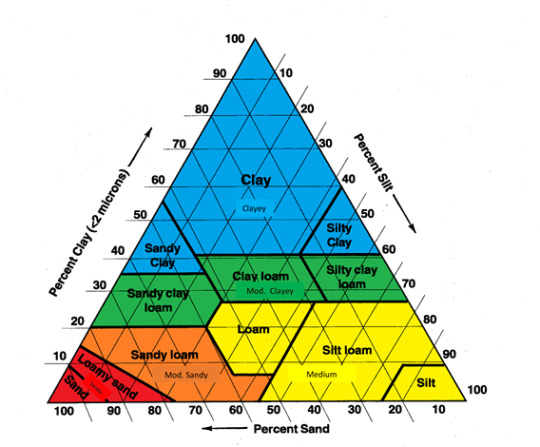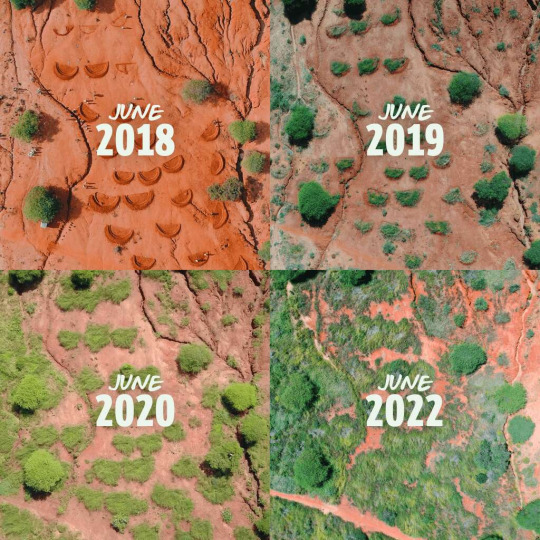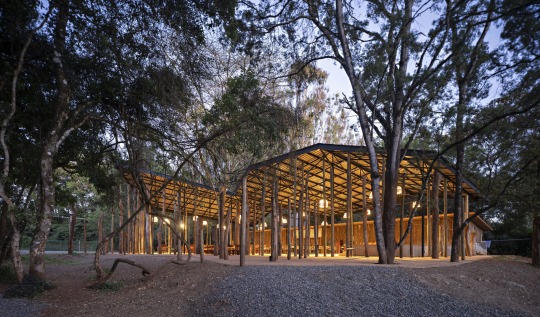#SOiL
Explore tagged Tumblr posts
Text
Guys, soil quality matters. Like, a lot. In good soil, you've got a SHITTON of little microbes. You've got earthworms. You've got little bugs. You've got fungi. You've got the roots of other plants. It's a whole-ass ecosystem in there. All that life is what breaks down the steak (or whatever else you drop on the dirt) and makes the nutrient-rich goodness that is humus and loam. The soil gets processed into little clumpy pieces that stick together and conveniently also hold onto water and oxygen and nutrients better.
If you drop a leaf in the dead of winter in the arctic, it won't decompose, because a lot of those good soil organisms can't survive that kind of environment, or they go dormant for the winter. Basically, same reason we preserve food with freezers or ice. Similarly, food buried in a landfill - in poisoned, dead, overworked soil - doesn't decompose properly either. All of which to say, if the carnivorous plant is carnivorous because "it doesn't have enough vitamins and nutrients so it has to survive" in its natural environment, that's poor quality soil to begin with, and turning it in to great soil that will be good at decomposing a steak well enough for a plant to benefit will take a lot more than just dropping a steak on it. (I wish it were that easy, honestly - city soil these days is REALLY dead.) That said, venus flytraps come from "temperate and subtropical wetlands", where I'd suspect the soil there is probably great, so maybe there's just so much competition from other plants for the nutrients in that soil that the venus flytrap benefits from eating food most other plants don't want. Plenty of non-plant things eat bugs too, but there's no shortage of bugs in the wilderness, and bugs don't suspect plant traps and will just land on them conveniently.
i think it's fucked up that there are plants that decided they wanted to eat meat
230K notes
·
View notes
Text


🌱✨️ "Living Soil" Embroidered Crewnecks & Hoodies ✨️🌱
Stay cozy while supporting soil health and sustainable farming 💚💛❤️
🌟 when you sign up for email offers and updates on our website, you get a chance to win up to 50% OFF your order!
🌟 FREE SHIPPING for orders over $50!!!
#soil health#soil science#soil#permaculture#environmental education#enviroment art#regenerative agriculture#regenerative farming#agriculture#sustainable living#sustainable farming#sustainability#organic life#organic matter#organic lifestyle#organic farming#organic#compost lifestyle#composting#compost#vermicompost#biodiversity#ecomindset#conservation#microbes#plant life#plant lover#street style#hippie#stoner society
567 notes
·
View notes
Text

vote for one and when this poll closes we will see what we make!
2K notes
·
View notes
Text
"An environmental toxicologist in California is cleaning up areas contaminated with heavy metals or other pollutants using fungi and native plants in a win-win for nature.
Where once toxic soils in industrial lots sat bare or weed-ridden, there are now flowering meadows of plants and mushrooms, frequented by birds and pollinators: and it’s thanks to Danielle Stevenson.
Founder of DIY Fungi, the 37-year-old ecologist from UC Riverside recently spoke with Yale Press about her ongoing work restoring ‘brownfields,’ a term that describes a contaminated environment, abandoned by industrial, extraction, or transportation operations.
A brownfield could be an old railway yard or the grounds of an abandoned oil refinery, but the uniting factor is the presence of a toxic containment, whether that’s a petrochemical, heavy metal, or something else.
Noting that she had read studies about mushrooms growing around the Chernobyl nuclear plant, she came to understand further, through her work, that fungi are an extraordinarily resilient species of life that consume carbon, and even though petroleum products are toxic to plants, to mushrooms they are essentially a kind of carbon.
In fact, mushrooms break down several categories of toxic waste with the same enzymes they use to consume a dead tree. They can also eat plastic and other things made out of oil, like agrochemicals.
At the Los Angeles railyard, as part of a pilot project, Stevenson and colleagues planted a variety of native grass and flower species alongside dead wood that would incubate specific fungi species called arbuscular mycorrhizal fungi, which assists plants in extracting heavy metals like lead and arsenic from the soil.
Alongside traditional decomposer fungi, the mixture of life forms demonstrated tremendous results in this brownfield.
“In three months we saw a more than 50 percent reduction in all pollutants. By 12 months, they were pretty much not detectable,” Stevenson told Yale 360.
Decontaminating soil like this typically involves bringing in a bulldozer and digging it all up for transportation to a landfill. This method is not only hugely expensive, but also dangerous, as contaminated material can scatter on the winds and fall out of the backs of trucks carting it away.
By contrast, the plants that draw out the toxic metals can be harvested and incinerated down to a small pile of ash before cheap transportation to a hazardous waste facility.
The technique, which Stevenson says has some scaling issues and issues with approval from regulators, is known officially as bioremediation, and she’s even used it to safely break down bags of lubricant-soaked rags from bicycle repair shops.
“People who live in a place impacted by pollution need to have a say in how their neighborhood is being cleaned up. We need to empower them with the tools to do this,” she said."
-via Good News Network, July 16, 2024
#mushrooms#fungi#mycology#mushroom#contamination#bioremediation#hazardous waste#hazardous materials#soil#mining#heavy metals#good news#hope#ecopunk#solarpunk
1K notes
·
View notes
Text

#I have an idea for like actually making it like your horoscope signs like april is sand idk#random crap#soil#meme bullshit
300 notes
·
View notes
Text
Scientists have discovered a new phylum of microbes in Earth's Critical Zone, an area of deep soil that restores water quality. Ground water, which becomes drinking water, passes through where these microbes live, and they consume the remaining pollutants. The paper, "Diversification, niche adaptation and evolution of a candidate phylum thriving in the deep Critical Zone," is published in the Proceedings of the National Academy of Sciences. Leonardo da Vinci once said, "We know more about the movement of celestial bodies than about the soil underfoot." James Tiedje, an expert in microbiology at Michigan State University, agrees with da Vinci. But he aims to change this through his work on the Critical Zone, part of the dynamic "living skin" of Earth.
Continue Reading.
168 notes
·
View notes
Text
RPTU University of Kaiserslautern-Landau has shown for the first time, in a joint study with BOKU University, that permaculture brings about a significant improvement in biodiversity, soil quality and carbon storage. In view of the challenges of climate change and species extinction, this type of agriculture proved to be a real alternative to conventional cultivation—and reconcile environmental protection and high yields. Permaculture uses natural cycles and ecosystems as blueprint. Food is produced in an agricultural ecosystem that is as self-regulating, natural and diverse as possible. For example, livestock farming is integrated into the cultivation of crops or the diversity of beneficial organisms is promoted in order to avoid the use of mineral fertilizers or pesticides. In a study, published in the journal Communications Earth & Environment, researchers from RPTU and BOKU have now, for the first time, comprehensively investigated the effects of this planning and management concept on the environment.
[...]
"Permaculture appears to be a much more ecologically sustainable alternative to industrial agriculture," said Julius Reiff . At the same time, the yields from permaculture are comparable to those of industrial agriculture, as the researchers' not yet published data shows. "In view of the challenges of climate change and biodiversity loss, the observed improvements would represent a real turnaround when applied to larger areas," says ecosystem analysis expert Martin Entling from RPTU.
4 July 2024
466 notes
·
View notes
Text
Making Desert Land Fertile with Water Bunds

#permaculture#regenerative ag#regenerative agriculture#agriculture#farming#gardening#how to make soil more fertile#how to turn a desert into fertile land#soil#soil fertility#organic farming#organic gardening#water harvesting
3K notes
·
View notes
Text


moss pond coaster, 2024. ~4” by 4” punchneedle. thrifted yarns, wool roving.
sold - inquire for a commission at k.times.two.works (at) gmail.com
#moss#punchneedle#tufting#tufted#handtufted#dirt#soil#nature#natureart#green#brown#blue#goblincore#forestcore#fiberart#art#grass#pond
240 notes
·
View notes
Text






5 of my favorite veggies to grow 🍠
#mine#plants#plant daddy#garden#farming#gardenblr#soil#black gardener#farmblr#okra#watermelon#squash#radishes#sweet potato
118 notes
·
View notes
Text

Microplastics are quietly moving from soil into crops like lettuce, wheat, and carrots, ultimately reaching the human food supply. Agricultural soils now contain about 23 times more microplastics than the oceans, and these tiny plastics have been detected in a variety of food plants.
141 notes
·
View notes
Text


Little critters of the Soil 💖 Stickers I made last year to sensibilize to their importance and how cute they can be! For the survival of biodiversity and life on Earth, we have to protect the soil 🙏 ☀️ Keep it covered and lively, consider sustainable mowing and leaving dead leaves and woods on the ground! At least in corners. Eat organic and don't use pesticides.
Talk about it around you 💖 We need them and they need us !!
126 notes
·
View notes
Text
A new study demonstrates that invasive plants don't just directly compete with native species at a direct, macro level, but the ability they have to connect with mycorrhizal partners have a negative impact on the soil microbiome into which they are introduced. It also makes the point that the relationship between a plant and its mycorrhizal partners does not occur in a vacuum, but within the wider community of plants and the various beings in the soil microbiome.
All of this may seem common sense; after all, all of nature is interconnected in some way or another. However, mycorrhizal relationships are often presented in a 1:1 ratio, with a plant and its fungal partner working together in spite of whatever else is going on around them. It should come as no surprise that environmental factors can alter that relationship, and how effectively the partners exchange nutrients. In this case in particular, the invasive plant was able to tap into the mycorrhizal network, but less efficiently than its native neighbors.
Whether it can evolve more effective connections with soil fungi in the future remains to be seen. Moreover, this was a study done in a laboratory setting with two native plants and one invasive, and may not necessarily reflect the complexity of mycorrhizal networks in nature. Still, the fact that the introduction of a non-native plant species can affect how native plants and fungi interact is one more reason to remove invasive species whenever possible.
*"Myco" means fungus and "rhizo" means root. Some soil fungi wrap their mycelium around the roots of plants, or even grow into those roots. the plants then send carbon made from sunlight through photosynthesis down to the fungi, and the fungi give the plants phosphorus and other nutrients from the soil in a mutually beneficial relationship.
#plants#fungi#mycorrhizal fungi#invasive species#invasive plants#native plants#ecology#restoration ecology#nature#botany#mycology#soil#soil science#soil health#science#scicomm#environment#conservation
133 notes
·
View notes
Text












Nairobi Waldorf School, Kenya,
Classrooms are enveloped in wooden logs to harmonize with their forested environment. The project located in forest clearings, features a series of temporary classrooms organized as a “small village” to serve the existing Nairobi Waldorf School.
Construction system was conceived to be adaptable and collaborative, engaging children, parents, and teachers in the process.
Whenever feasible, materials from dismantled classrooms were recycled – wooden floors and walls were transformed into parapets, and roof tiles were repurposed to define path boundaries, among other uses.
The construction materials were chosen for sustainability, including locally sourced red laterite soil from the site excavations for the ‘living walls’ and recyclable polycarbonate for transparency and efficiency
This approach seamlessly blended creativity, sustainability, and community involvement, resulting in a truly unique educational environment.
Courtesy: Urko Sanchez Architects
#art#design#architecture#minimal#nature#interior design#interiors#sustainability#sustainable architecture#school#kenya#recycled#nairobi#education#classroom#urko sanchez architects#village#forest#maasai bomas#hut#manyattas#living wall#polycarbonate#soil#educational architecture
106 notes
·
View notes
